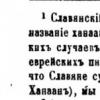Examples of bored foundation piles. Bored piles: device technology and calculation. Methods for determining the load-bearing capacity of a pile
The calculation of a pile foundation is performed depending on its type. It is important to understand that the calculation of bored piles will differ from the calculations for screw piles. But in all cases, preliminary preparation is required, which includes collecting loads and geological surveys.
Study of soil characteristics
The bearing capacity of a bored pile will largely depend on the strength characteristics of the base. First of all, it is worth finding out the strength characteristics of the soil on the site. To do this, two methods are used: manual drilling or digging holes. The soil is developed to a depth of 50 cm greater than the expected foundation level.




Load collection
Before calculating a bored foundation, it is also necessary to collect loads from all overlying structures. Two separate calculations are required:
This is necessary because a separate calculation of the pile foundation grillage and pile characteristics will be performed.
When collecting loads, it is necessary to take into account all elements of the building, as well as temporary loads, which include the mass of snow cover on the roof, as well as the payload on the floor from people, furniture and equipment.
To calculate a pile-grillage foundation, a table is compiled into which information about the mass of structures is entered. To calculate this table, you can use the following information:
| Design | |
|---|---|
| Frame wall with insulation, 15 cm thick | 30-50 kg/sq.m. |
| Wooden wall 20 cm thick | 100 kg/sq.m. |
| Wooden wall 30 cm thick | 150 kg/sq.m. |
| Brick wall 38 cm thick | 684 kg/sq.m. |
| Brick wall 51 cm thick | 918 kg/sq.m. |
| Plasterboard partitions 80 mm without insulation | 27.2 kg/sq.m. |
| Plasterboard partitions 80 mm with insulation | 33.4 kg/sq.m. |
| Interfloor ceilings on wooden beams with insulation installation | 100-150 kg/sq.m. |
| Interfloor reinforced concrete floors 22 cm thick | 500 kg/sq.m. |
| Roofing pie using a coating made of |
|
| sheets of metal tiles and metal | 60 kg/sq.m. |
| ceramic tiles | 120 kg/sq.m. |
| bitumen shingles | 70 kg/sq.m. |
| Live loads | |
| From furniture, people and equipment | 150 kg/sq.m. |
| from the snow | determined according to table. 10.1 SP "Loads and impacts" depending on the climatic region |
The dead weight of the foundations and grillage is determined depending on the geometric dimensions. First you need to calculate the volume of the structure. The density of reinforced concrete is assumed to be 2500 kg/cub.m. To get the mass of an element, you need to multiply the volume by the density.
Each component of the load must be multiplied by a special coefficient, which increases reliability. It is selected depending on the material and manufacturing method. The exact value can be found in the table:
Pile calculation
At this stage of calculations, it is necessary to determine the following characteristics:
- pile pitch;
- length of the pile to the edge of the grillage;
- section.
Most often, the cross-sectional dimensions are determined in advance, and the remaining indicators are selected based on the available data. Thus, the result of the calculation should be the distance between the piles and their length.

The entire mass of the building obtained at the previous stage must be divided by the total length of the grillage. This takes into account both external and internal walls. The result of the division will be the load on each linear meter of the foundations.
The bearing capacity of one foundation element can be found using the formula:
P = (0.7 R S) + (u 0.8 fin li), where:
- P is the load that one pile can withstand without destruction;
- R is the strength of the soil, which can be found from the tables presented below after studying the composition of the soil;
- S is the cross-sectional area of the pile in the lower part, for a round pile the formula is as follows: S = 3.14*r2/2 (here r is the radius of the circle);
- u is the perimeter of the foundation element, can be found using the formula for the perimeter of a circle for a circular element;
- fin is the soil resistance on the sides of the foundation element, see the table for clay soils above;
- li is the thickness of the soil layer in contact with the side surface of the pile (found for each soil layer separately);
- 0.7 and 0.8 are the coefficients.
The pitch of the foundations is calculated using a simpler formula: l = P/Q, where Q is the mass of the house per linear meter of the foundation, found earlier. To find the clear distance between bored piles, the width of one foundation element is simply subtracted from the value found.

Reinforcement of bored piles is carried out in accordance with regulatory documents. Reinforcement cages consist of working reinforcement and clamps. The first takes on bending influences, and the second ensures the joint work of individual rods.
Frames for bored piles are selected depending on the load and cross-sectional dimensions. The working reinforcement is installed in a vertical position; steel rods D from 10 to 16 mm are used for it. In this case, a material of class A400 (with a periodic profile) is selected. To manufacture transverse clamps, you will need to purchase smooth reinforcement of class A240. D = minimum 6-8 mm.

The frames of bored piles are installed so that the metal does not reach 2-3 cm beyond the edge of the concrete. This is necessary to provide a protective layer that prevents the occurrence of corrosion (rust on the reinforcement).
Grillage dimensions and reinforcement
The element is designed in the same way as a strip foundation. The height of the grillage depends on how much the building needs to be raised, as well as on its mass. You can independently calculate an element that rests flush with the ground, or is slightly recessed into it. The basis of calculations for the hanging option is too complex for a non-specialist, so this work should be entrusted to professionals.
 An example of correct tying of reinforcement cage
An example of correct tying of reinforcement cage The dimensions of the grillage are calculated as follows: B = M / (L R), where:
- B is the minimum distance for supporting the tape (width of the strapping);
- M is the mass of the building without taking into account the weight of the piles;
- L - strapping length;
- R is the strength of the soil at the surface of the earth.
The reinforcement frames of the strapping are selected in the same way as for a building on a strip foundation. In the grillage it is necessary to install working reinforcement (along the tape), horizontal transverse, vertical transverse.
The total cross-sectional area of the working reinforcement is selected so that it is not less than 0.1% of the cross-section of the tape. To select the cross-section of each rod and their number (even), use the reinforcement assortment. It is also necessary to take into account the instructions of the joint venture on the smallest sizes.
Calculation example
To better understand the principle of calculations, it is worth studying an example calculation. Here we are considering a one-story brick building with a hip roof made of metal tiles. The building is supposed to have two floors. Both are made of reinforced concrete with a thickness of 220 mm. The dimensions of the house are 6 by 9 meters. The thickness of the walls is 380 mm. Floor height - 3.15 m (from floor to ceiling - 2.8 m), total length of internal partitions - 10 m. There are no internal walls. A refractory sandy loam with a porosity of 0.5 was found on the site. The depth of this sandy loam is 3.1 m. From here we find from the tables: R = 46 tons/sq.m., fin = 1.2 tons/sq.m. (for calculations, the average depth is assumed to be 1 m). Snow load is taken according to Moscow values.
We collect loads in the form of a table. At the same time, do not forget about the reliability coefficients.
| Type of load | Calculation |
|---|---|
| Brick walls | wall perimeter = 6+6+9+9 = 30 m; wall area = 30 m*3m = 90 m2; wall mass = (90 m2* 684)*1.2 = 73872 kg |
| Partitions made of plasterboard, not insulated, 2.8 m high | 10m*2.8*27.2kg*1.2 = 913.92 kg |
| Flooring made of reinforced concrete slabs 220 mm thick, 2 pcs. | 2pcs*6m*9m*500 kg/m2 *1.3 = 70200 kg |
| Roof | 6 m*9 m*60 kg*1.2 /сos30ᵒ (roof slope) = 4470 kg |
| Load from furniture and people on 2 floors | 2*6m*9m*150kg*1.2 = 19440 kg |
| Snow | 6m*9m*180kg*1.4/cos30° = 15640 kg |
| TOTAL: | 184535.92 kg ≈ 184536 kg |
We preliminarily designate a grillage 40 cm wide and 50 cm high. The length of the pile is 3000 mm, D section = 500 mm. We use an approximate pile spacing of 1500 mm.
To calculate the total number of supports, you need to divide 30 m (length of the grillage) by 1.5 m (pile pitch) and add 1 pc. If necessary, the value is rounded down to the nearest whole number. We get 21 pieces.
Area of one pile = 3.14 0.52/4 = 0.196 sq.m., perimeter = 2 3.14 0.5 = 3.14 m.
Let's find the mass of the grillage: 0.4 m 0.5 m 30 m 2500 kg/cub.m. 1.3 = 19500 kg.
Let's find the mass of piles: 21 3 m 0.196 sq.m. 2500 kg/cub.m. 1.3 = 40131 kg.
Let's find the mass of the entire building: the sum from the table + the mass of the piles + the mass of the grillage = 244167 kg or 244 tons.
For the calculation, the load per linear meter of the grillage will be required = Q = 244 t/30 m = 8.1 t/m.
Calculation of piles. Example
We find the permissible load on each element using the formula indicated earlier:
P = (0.7 46 tons/sq.m. 0.196 sq.m.) + (3.14 m 0.8 1.2 tons/sq.m. 3 m) = 15.35 tons.
The pitch of the piles is taken to be P/Q = 15.35/8.1 = 1.89 m. Round up to 1.9 m. If the step is too large or small, you need to check several more options, changing the length and diameter of the foundations.
For frames, rods D = 14 mm and clamps D = 8 mm are used.
Grillage calculation. Example
It is necessary to calculate the mass of the building without taking into account the piles. Hence M = 204 tons.
The width of the tape is assumed to be M / (L R) = 204 / (30 75) = 0.09 m.
Such a grillage cannot be used. The overhang of the walls of a brick building from the foundation should not exceed 4 cm. The width is set to 400 mm. The height remains at 500 mm.
Reinforcement of the pile foundation grillage:
- Working 0.1%*0.4*0.5 = 0.0002 sq.m. = 2 sq. cm. Here, 4 rods with a diameter of 8 mm will be sufficient, but according to regulatory requirements we use the minimum possible diameter of 12 mm;
- Horizontal clamps - 6 mm;
- Vertical clamps - 6 mm.
The calculations will take a certain amount of time to complete. But with their help you can save money and time during the construction process.
You can also calculate the foundation using an online calculator. Just click on the link Calculation of a columnar foundation and follow the instructions.
Drilling bored piles has become popular due to the speed and ease of use.
Bored reinforced concrete pipes differ in parameters: from 0.5 to 1.5 m in diameter and up to 40 m in length. They are effective under heavy loads.
Pile foundation technology
Before considering an example of calculating bored supports, it is necessary to become familiar with the technology of arranging a pile foundation. First you need to drill a well and then fill it with concrete solution.
If construction is carried out on dense soils, then you can do without formwork. In all remaining cases, formwork is required. It can be made of roofing felt or asbestos-cement pipes.
Since the support is subject to tensile load from the soil, its cavity must be reinforced. For this purpose, steel reinforcement bars are used. They must be installed vertically and then connected horizontally with narrower rods.
To install vertical rods, 10-12 mm rods are used. To make reinforced concrete pipes rigid, horizontal fastening with smooth reinforcement 6-8 mm is used. The step between them should be about 1 meter.
If you plan to arrange a grillage, you must leave an allowance for the rods so that they stick out from the supports. The protruding elements will then act as a bundle of piles with supports.
When building a house, the installation of bored piles occurs in rows under all load-bearing walls, always at the corners of the structure, at the intersections of walls and between them. To calculate a bored foundation, determine the number and diameter of supports, as well as the distance between them, it is necessary to take into account the weight of the house.
The more massive the house, the more piles will be required in smaller increments.
There are rules for minimum parameters for the installation of supports. For example, they should not be installed more often than three times their own diameter. Too dense arrangement of supports reduces load-bearing capacity.

For example, with a diameter of the supporting elements of 40 cm, the smallest step between the supports should be 120 cm.
Where to start the calculation?
Having decided to use bored technology when building your own house, you need to perform the following analytical manipulations:
- assess soil structure;
- calculate the load of the future building;
- calculate the area of the base;
- calculate the size of bored piles and their number;
- calculate the distance between bored piles for pipe drilling.
As for the soil, as the table indicates, the best bearing capacity indicators are rocky and semi-rocky soil. Other types of soil (clayey, sandy, sandy loam, loam, etc.) are characterized by a high degree of heaving, that is, the ability to push out the foundation when the soil freezes.
To calculate the load that a future building will place on the ground and foundation, it is necessary to sum up the amount of building materials that will be used in the construction of the building. For this purpose, a table of their average specific gravity is used.
First, the quadrature of each building element is calculated. Then you need to look at the weight of each building material and multiply by the square footage.
For example, a sheet steel roof weighs 20-30 kg/m2. With a roof area of 100 m2, it turns out that its total weight is 2000-3000 kg.
To calculate bored piles, their number and parameters, it is necessary to take into account the area of their base. Let's take the following example: the diameter of the pipe is 300 mm, its base with expansion has a size of 500 mm.
Pile area S = pi x D2/4 = 3.14 × 50 × 50/4 = 1960 cm 2. If the pressure on the foundation F is 100,000 kg, R = 4, then according to the formula R=F/(S×n), where n is the number of supports, the total number of piles will be 13 pieces.
For each type of soil, the load-bearing capacity of the pile pipe will be different. For fast and accurate parameter calculations a special table is used. It indicates the ratio of the calculated soil resistance, the diameter of the pile and approximate indicators of its bearing capacity.
For example, the parameters for a support with a diameter of 400 mm on gravelly soils with a density of 4.5 kg/cm 2 are 5600 kg.
Calculation of the bearing capacity of the pile
The calculation of the load-bearing capacity demonstrated by driven piles is based not only on its diameter and base area, but also on the grade of concrete. Let's take this example: the cross-section of a bored pipe is 20x20 cm, and the cross-sectional area is 400 cm 2. When using concrete grade M100, such a support can withstand 100 kg/cm2. This means that the permissible weight per support is 40 t.
In this case, driven piles demonstrate load-bearing capacity indicators much greater than the bearing capacity of the soil. For this reason, when calculating the number of supports and the bearing capacity of the foundation, it is worth taking into account the density of the soil. On average, it is 6 kg/cm 2, provided that the piles are laid to a depth below the soil freezing level (from 2 m) and provided that the soil is dry.
The diameter of the pile affects the supporting area of the base and its load-bearing capacity.
To calculate bored piles taking into account the mentioned criteria, a table is used that shows the ratio of concrete density, diameter of the support, its area, and bearing capacity. For example, the table indicates that with a pile diameter of 15 cm, a support area of 177 cm 2 and a concrete volume of 0.0354 m 2, the bearing capacity of the support will be equal to 1062 kg.
Technological map of the CFA methodology
The technological model for the use of bored piles, as an alternative to traditional drilling, offers the CFA technology, which does not require casing pipes. Drilling using the CFA method is justified in areas with dense buildings, where conventional drilling can lead to structural changes in the foundations of neighboring buildings.
The CFA method has a second name - hollow screw method. The technological map of the CFA method provides for drilling without soil extraction.
Soil drilling according to CFA occurs gradually. After achieving the design indicators, the flow chart indicates that the well is filled through a full auger using a concrete pump. At the same time, the process of removing the auger from the recess is carried out.

The technological map provides that after pouring, reinforced frames are installed to impart rigidity to the structure.
The use of the CFA method in the construction of buildings eliminates ground vibration, and the supply of concrete with sediment under high pressure makes the driven piles stronger by strengthening the walls of the structure. Special requirements are set for reinforced frames using the CFA method. Among them:
- installation of the frame must be carried out as indicated in the technological map and design documentation;
- the outer diameter of the structure must be smaller than the screw;
- installation of plastic centralizers is required along the entire length of the frame;
- as the technological model shows, the lower part of the frame should have the shape of a cone. This requires installation of the last ring with a diameter smaller than the previous ones.
Drilling using the CFA method has several advantages, including the ability to carry out work without using casing pipes. This significantly reduces construction costs.
Arrangement of a pile foundation (video)
Example of calculation of bored piles
Before drilling wells for piles, it is necessary to calculate them. How to do this is shown in the example.
Original dimensions:
- support diameter (d) – 5 m;
- length – 0 m;
- load on one support – x m multiplied by 5.5 tons (pressure per 1 meter of foundation length);
The bearing capacity of the support is calculated by the formula:
P = 0.7 x RH x F + u x 0.8 x fiн x li, where
- P – bearing capacity of the support;
- Rн – standard soil resistance;
- F – area of the pile base;
- u – pile perimeter;
- 8 – coefficient of working conditions;
- 7 – coefficient of soil homogeneity;
- Fін – soil resistance along the outer side of the support;
- li is the thickness of the soil layer that is in contact with the support.

The bearing capacity of wet soil, as shown in the corresponding table, is 70 t/m2 (Rн). Sectional area of the support (S) = 3.14 D 2 /4 = 3.14 x 0.25 / 4 = 0.785/4 = 0.196 m2. Support perimeter (u) = 3.14 D = 3.14 x 0.5 = 1.57 m.
The operating conditions coefficient, as shown in the corresponding table, is 0.8.
The bearing capacity of the support is P = 0.7 x 1 = 15.4 tons.
The minimum distance between supports is 15.4 tons / 5.5 tons/m = 2.8 meters.
A characteristic indicator of the strength of a pile foundation is the bearing capacity of an individual pile. This characteristic affects the total number of piles in the perimeter of the foundation - by adjusting the frequency, you can increase the load limit that the foundation will be able to withstand. The number of bored piles and the load-bearing capacity of a single pile column are interrelated characteristics, the optimal ratio of which is determined by carrying out simple calculations.
Preparation for calculation

The initial data that will be needed to calculate the bearing capacity of a bored pile is obtained as a result of geological surveys and calculation of the total expected load of the building. These are mandatory stages of calculation, the implementation of which is justified by the theory of calculating the strength characteristics of bored foundations.
Indicators such as freezing depth, groundwater level, soil type and its mechanical characteristics are very important for obtaining an accurate result. Information on the depth of soil freezing is in SNiP 2.02.01-83*, the data is divided by climatic regions, presented cartographically and in the form of tables.
You should not rely on geological and hydrogeological exploration data obtained in neighboring areas. Even within the perimeter of one plot of land, the condition of the foundation soils can change dramatically. Three or four monitoring wells at perimeter control points will provide accurate information about the condition of the soil.
The calculation of the mass of a building is carried out taking into account the climatic region, the location of the building relative to the direction of the winds, the average amount of precipitation in winter, the mass of building structures and equipment. This indicator is most significant when designing a foundation - the data for this part of the calculation, as well as the diagram and calculation formulas can be found in SNiP 2.01.07-85.
Conducting geology

Conducting geological surveys is a responsible undertaking, and in mass production construction this is carried out by specialist geologists. In individual housing construction, independent assessment of soil conditions is often carried out. Without experience in conducting research of this level, it is very difficult to assess the real state of affairs. The work of a competent specialist largely consists of visually assessing the state of the strata.
To begin with, pits are arranged on the site - vertical excavations of rectangular or circular section, with a depth of two meters and a width sufficient for visual inspection of the base of the pit walls. The purpose of the holes is to open the soil in order to gain access to the strata hidden under the top layer of soil. Geologists measure the depth of the layers, take a soil sample from the middle of each layer, and subsequently observe the accumulation of water at the bottom of the face. Instead of holes, round wells can be installed, from which cores are removed using a special device or local samples are taken.
The pits are covered for some time - two to three days - limiting the ingress of precipitation. Afterwards, the water level that has risen in the well cavity is assessed - this mark, measured from the upper boundary, will be the groundwater level.
All received data is entered into a summary table. In addition, a soil section profile is compiled, which allows one to predict the condition of the soil at points where drilling was not carried out. When independently assessing the foundations, you should be guided by the information presented in SNiP 2.02.01-83* and GOST 25100-2011, where the relevant sections present classifications of soils with descriptions, methods for visually determining soil types and characteristics in accordance with the types.
How to use geological survey data

After the geology of the area has been carried out - independently or by hired specialists - you can begin to determine the initial geometric characteristics of the piles.
We are interested in the type of soil, the coefficient of soil heterogeneity, the depth of freezing and the level of groundwater. The scheme for calculating the bearing capacity of a bored pile for various types of soil is in the appendices of SP 24.13330.2011.
The depth of the pile should be at least half a meter below the freezing depth in order to prevent the impact of frost heaving of the soil on the supporting part of the column. The average freezing depth in central Russia is 1.2 meters, which means that the minimum length of the pile should be 1.7 meters in this case. The value varies for individual regions.
Not only relative humidity, but also the relative position of the lower freezing mark of the soil and the depth of groundwater. In the cold season, high-lying frozen groundwater will exert strong lateral pressure on the body of the pile column - such soils are greatly deformed and are considered heaving.
Some soils, characterized as weak, highly heaving and subsidence, are not suitable for constructing pile foundations - strip or slab foundations are more suitable for them. Determining the type of soil, as well as the type of compatible foundation, means eliminating the rapid destruction of structures. The soil heterogeneity indicators indicated in the tables of the above regulatory documents are used in further calculations.
Total load calculation
 Collecting loads allows you to determine the mass of the building, which means the force with which the building will act on the foundation as a whole and on its individual elements. There are two types of loads acting on a supporting structure - temporary and permanent. Dead loads include:
Collecting loads allows you to determine the mass of the building, which means the force with which the building will act on the foundation as a whole and on its individual elements. There are two types of loads acting on a supporting structure - temporary and permanent. Dead loads include:
- A lot of wall structures;
- Total mass of floors;
- A lot of roofing structures;
- Mass of equipment and payload.
You can calculate the mass of structures by determining the volume of the structures and multiplying it by the density of the material used. An example of calculating the mass for a one-story building with reinforced concrete floors, a roof made of ceramic tiles and walls of 600 mm made of reinforced concrete, dimensions 10 by 10 meters in plan, floor height 2 meters:
- We calculate the volume of the walls by multiplying the cross-sectional area of the wall by the perimeter. We get V walls = 20 ∙ 2 ∙ 0.6 = 24 m3. We multiply the resulting value by the density of heavy concrete, which is equal to 2500 kg/cm3. The final mass of wall structures is multiplied by the reliability coefficient, for concrete equal to k = 1.1. We get the mass M of the wall = 66 tons.
- Similarly, we calculate the volume of floors (basement and attic), the mass of which with a thickness of 250 mm will be equal to Mpc = 137.5 tons, taking into account a similar reliability factor.
- We calculate the mass of roof structures. Roofing weight for 1 m2 of metal tiles is 65 kg, soft roofing is 75 kg, ceramic tiles are 125 kg. The area of a gable roof for a building with such a perimeter will be approximately 140 m2, which means the mass of the structures will be Mkr = 17.5 tons.
- The total size of the permanent load will be equal to Mpost = 221 t.
Reliability factors for various materials are found in the seventh section of SP 20.13330.2011. When calculating, the mass of partitions, façade cladding materials and insulation should be taken into account. The volume occupied by window and door openings is not subtracted from the total volume for ease of calculation, since it constitutes an insignificant part of the total mass.
Calculation of live loads
 Grillage on screw piles
Grillage on screw piles Live loads are calculated in accordance with the climatic region and the instructions in the “Loads and Actions” code of practice. Temporary loads include snow and payloads. The useful load for residential buildings is 150 kg per 1 m2 of flooring, which means the total useful weight will be equal to Mpol = 15 tons.
The weight of the equipment that is supposed to be installed in the building is also summed up in this indicator. For a certain type of equipment, a reliability factor is applied, located in the above set of rules.
There are various types of special loads that also need to be taken into account in the design. These are seismic, vibration, explosive and others.
![]()
where ce is the snow drift coefficient equal to 0.85;
ct – thermal coefficient equal to 0.8;
m – transition coefficient, for buildings with a plan less than 100 m, adopted according to Table D of the above SP;
St – weight of snow cover per 1 m2. Accepted according to table 10.1, depending on the snow area.
The indicators of temporary loads are summed up with permanent ones and a quantitative indicator of the total load of the building on the foundation is obtained. This number is used to calculate the load on one pile column and compare the ultimate strength. For the convenience of calculation and clarity of the example, we will accept temporary loads Mvr = 29 t, which in sum with the constant ones will give Mtot = 250 t.
Determination of the load-bearing capacity of a pile
The geometric parameters of the pile and the tensile strength are interrelated quantities. In this example, the load per meter of foundation will be 250/20 = 12.5 tons.
Calculation of the load limit on a single bored pile is carried out according to the formula:
![]()
where F is the limit of bearing capacity; R – relative soil resistance, an example of calculation of which is in SNiP 2.02.01-83*; A – cross-sectional area of the pile; Eycf, fi and hi – coefficients from the above SNiP; y is the perimeter of the pile column section divided by the length.
Watch the video on how to check the load-bearing capacity of a pile using professional equipment.
For a one and a half meter long pile with a diameter of 0.4 meters, the load-bearing capacity will be 24.7 tons, which makes it possible to increase the pitch of pile columns to 1.5 meters. In this case, the load on the pile will be 18.75 tons, which leaves a fairly large margin of safety. By changing the geometric characteristics, as well as the pitch of the pile columns, the load-bearing capacity is regulated. This table below shows the dependence of the load-bearing capacity of a one and a half meter pile on its diameter:
 Dependence of bearing capacity on pile width
Dependence of bearing capacity on pile width There are many services that allow you to calculate the load-bearing capacity of a pile online. You should only use trusted portals with good reviews.
It is important not to exceed the permissible load on the pile and leave a margin of safety - few services can plan load distribution, so you should pay attention to the calculation algorithm.
“To dig or not to dig” - this Hamlet question when building a house is resolved unambiguously: to dig. It gives rise to several challenges: what foundation to choose, to what depth to pour it, how to do everything reliably and not too expensively?
A trench strip foundation is a common option for developers for the supporting part of a building. In addition to its positive qualities, it has serious disadvantages. The main ones are high material consumption and labor intensity.
The base of the concrete “ribbon” must be poured below the freezing mark of the soil. In central Russia this is at least 1.2 meters. In more severe climatic conditions, to protect against frost heaving, dozens of “cubes” of concrete have to be driven even deeper.
If construction is carried out on soft soil, then digging below the freezing horizon will not save the building from settlement. It is not always possible to reach a dense base on which the reinforced concrete “ribbon” will rest securely. In this case, the only option left is a foundation on bored piles.
In terms of cost, it is cheaper than belt construction, does not require the use of powerful earth-moving equipment, and is built faster. We will talk about what such a structure is, how it is calculated and built, in this article.
Getting to know the bored foundation
The idea of a bored foundation is very simple: where it is impossible to get to dense soil with minimal effort, you can use long posts. To connect them into a common structure, a grillage is used - a monolithic reinforced concrete tape connecting the pile heads.

It is useful to know that piles are very different from conventional massive foundations in the nature of their interaction with the soil. The pile transmits the load in two ways: through the lower end (heel) and through the side surface due to friction forces between the wall and the soil.
Depending on what part of the structure is included in the work, all bored piles are divided into two types:
- Racks.
- Hanging.
The pile-rack rests on a dense soil layer. The hanging structure holds the load only due to the force of contact with the surrounding soil. Since the dense natural foundation lies quite deep, a significant part of the bored structures are of the hanging type.

Classification, calculation and other important parameters, without which it is impossible to install bored piles, are contained in SNiP 2.02.03-85– a reference book for all designers and contractors. The developer can be guided by ready-made tables from this standard. They indicate the load-bearing capacity of the support posts. Knowing it and determining the weight of the building, you can select the required number of piles.

The data indicated in the table is indicative. The exact value of the bearing capacity of a bored pile is calculated using a formula that takes into account several parameters:
- diameter;
- brand of concrete;
- type of reinforcement;
- drilling depth;
- mechanical strength of the soil.
After all that has been said, the question arises: for which buildings is the construction of a bored foundation with a grillage justified? Some developers believe that such a structure is not able to withstand heavy loads, so they use it only for light frame buildings, as well as houses made of timber, gas or foam concrete. This is wrong. Today thousands of nine-story brick buildings stand on stilts and no one doubts their reliability.

The strength of a drilled rack manufactured in the field is slightly lower than that of a structure that has gone through a full cycle of factory processing. However, it is sufficient to build a brick house.
The main condition for quality in this case is correct calculation and strict adherence to technology, which includes several stages:
- Drilling a well for bored piles (manual motor drill or more powerful mobile unit).
- Installation of casing pipe (in loose and damp soils).
- Installation of reinforcement cages.
- Well concreting.
- Filling of a sand-crushed stone cushion under the grillage (thickness 10-15 cm), compensating for the rise of the soil as a result of frost heaving.
- Installation of formwork above the ground, installation of reinforcement and pouring of the grillage connecting the piles.
Features of calculating a pile foundation
The first step from which the calculation of a pile field begins is determining the weight of the building. It will depend on him how many piles, what diameter and to what depth we will have to install. The heavier the house, the denser the piles are placed under the walls.
At the same time, the standard requires that the distance between the centers of adjacent supports was at least 3 pile diameters. As this distance decreases, the load-bearing capacity of the racks decreases.

Reinforcement of piles is carried out with vertical rods of a periodic profile (diameter 12-14 mm). Their number depends on the diameter of the rack and can range from 3 to 8 pieces. The vertical reinforcement is connected to each other by horizontal sections of rods with a diameter of 6-8 mm. Bored piles must be filled with concrete of grade no lower than 100.
To more easily calculate the cost of materials and load-bearing capacity of piles, you can use the table below.

The table shows the calculation of bored piles with a length of 2 meters and a diameter of 15 to 40 cm. The vertical reinforcement is 12 mm, the transverse reinforcement is 6 mm in increments of 1 meter.
As an example, let’s determine how many piles with a diameter of 20 cm are required for the foundation of a house that weighs 60 tons. The table shows that one rack can support a weight of no more than 1884 kg. Dividing 60,000 kg by 1884 kg, we get 31.84 pieces. We round up to the nearest whole number and get 32 piles. To fill them (without siege pipes), you need to buy reinforcement and concrete with a total cost of 32x428.68 rubles. = 13,717 rub.
Of course, the final cost of your foundation will be much higher, since its cost will include many other costs: excavation work, delivery of building materials, grillage installation, services of workers and equipment. However, if you wish and objectively assess your strengths, all or part of the work can be done with your own hands.
The resulting number of pile supports must be evenly distributed under the load-bearing walls and partitions of the building, as well as at all angles and intersections of the walls. In this case, the pitch of the piles will depend on the total length of the walls.
Any person who has ever put his efforts into building a house knows that the basis for the durability and reliability of a building is its foundation. However, creating a solid foundation is not as easy a task as it might initially seem.
A foundation made of bored piles is cheaper than a strip foundation, and at the same time more reliable due to its location below the depth of soil freezing.
Laying any foundation for a house, depending on the type of foundation, requires careful calculation.
Such calculations include, for example, the bearing capacity of a bored pile.
If the underlying soils do not cause any particular problems, then almost any house can get by with a regular strip foundation. It’s another matter if the soils under the construction site are problematic: peat bogs, swampy or highly heaving. It is necessary to build houses on such moving soils with caution, following the technology. According to experienced builders, the optimal solution for problem soils is the use of bored piles, which are combined at the top with a strip monolithic foundation or grillage.
What is the advantage of bored piles?
A pile foundation is much cheaper than a strip foundation (up to 20-50%) or slab foundation (up to 2-4 times). In this case, bored piles rest on a stable parent rock located below the freezing depth, which prevents their movement in the vertical plane during soil heaving. The exception is those soils whose parent rocks are located deeper than 8-10 m. On them, it is more advisable to use a monolithic slab as a foundation, which will “float” along with the underlying soils.
Screw posts, which have recently become increasingly popular, also rest their base on the parent rock, but they are often susceptible to corrosion, since the zinc or paint layer on their surface wears off when screwed into the ground. For comparison, the service life of a screw foundation is estimated by experts to be 40-50 years, while it is capable of serving for a much longer period. A pile-screw foundation can be just as durable if the metal pipes are filled from the inside with concrete, but this dramatically increases its cost and feasibility.
Return to contents
Technology of using bored piles
The main feature of using bored piles is their pouring directly at the construction site. The only difficulty is drilling wells for filling, since it is hard manual labor (heavy equipment for drilling wells cannot always reach the construction site in case of problematic soils). However, technology does not stand still and the construction market offers many solutions for drilling wells: from gasoline to electric non-industrial drills and drilling rigs. Supports with an extended lower part are especially reliable, but they are more complex to manufacture.
Laying a foundation of this type is the process of drilling a well of the required depth into which a frame made of reinforcement is placed. Reinforcement will give the pile bending or fracture strength in the horizontal plane. After placing the reinforcement, the well is filled with concrete level with the ground level or, if necessary, above it, but with the construction of appropriate formwork. The formwork is made from available materials (roofing felt, asbestos pipe or boards) to the height required by the project.
The head must be accessible for connection to the grillage. Most often, the end of the reinforced frame is left above the surface, which will connect the finished supports with the grillage.
Return to contents
Calculation of the main characteristics of bored piles
Return to contents
Load-bearing capacity is the main characteristic of a bored pile
When creating a pile foundation, one cannot ignore such a parameter as the load-bearing capacity of each support, since both the consumption of materials for their creation and the number of pillars themselves for reliable support of the building depend on this.
The load-bearing capacity directly depends on the size of the pillar. For example, a bored pile with a diameter of 300 mm can withstand a load of 1.7 tons, while a pile with a diameter of 500 mm can already withstand 5 tons. With a slight difference in size, the load differs significantly.
Based on this, the correct calculation of supports ensures a reliable foundation for the house. In addition, their quantity and the amount of material required for their manufacture directly depend on them. Therefore, calculating the number of bored piles and the optimal distance between them (another important parameter of a pile foundation) is a common component for building a house.
Return to contents
Material of manufacture
As mentioned earlier, the load-bearing capacity of a bored pile depends on its size. However, this is not the only criterion used to calculate the bearing capacity of a pile foundation. It is equally important to consider the material from which it is made. The grade of concrete used to pour the structure directly affects the strength of the foundation and the loads it can withstand.
For example, a pile filled with M 100 concrete is theoretically capable of withstanding a load of 100 kg per 1 cm² of its support area. This figure is quite high, since a square pile with a base side of 20 cm and an area of 400 cm² must withstand a load of 40 tons. The calculation showed that the bearing capacity directly depends on the material from which the foundation is made.
In addition, it is important to take into account not only the load that each pile can withstand, but also the bearing capacity of the underlying soils themselves. Accordingly, if there is an insufficient number of pillars and an increased load on the soil, the foundation may collapse due to the fact that individual piles go further into the depth.
The stronger the underlying soils, the fewer supports are needed to build a high-quality foundation for a house. In addition, it is necessary to take into account the depth of soil freezing in a given area, the groundwater level, the immediate length of structures, the strength of reinforcement, and so on.
Return to contents
The cost of a pile foundation
All of the above parameters affect the quantity and quality of pillars, on which the total cost of the pile foundation depends. : for a diameter of 15 mm, laid to a depth of 2 m, you need 0.035 m³ of concrete, 3 reinforcing rods 2 m long with a diameter of 12 mm and a certain amount of smooth reinforcement for tying them. Taking into account the fact that all these materials will need to be delivered to the construction site, it turns out that the cost of each support (without taking into account the work of drilling and pouring them, the condition is accepted that all this work was carried out by you personally) is 180-200 rubles, and the total the cost of the foundation will be equal to the result of multiplying this figure by the total number of supports.
The resulting figure can be adjusted. For example, as already mentioned, bored piles with an expanded base are used in construction. Such a base is made using a special device (plow), which is placed on the tip of the drill. The plow is lowered into a completed well and rotates to expand its base. What does such a step achieve? An ordinary pile with a diameter of 200 mm can withstand a load of 1 ton. If you expand its base to 300 mm, leaving the rest of the well unchanged, then the bearing capacity will increase to 2 tons. That is, a slight increase in concrete consumption and a special device can significantly reduce the total, which will significantly reduce cost of the finished foundation.
After the load on the foundation is known, the bearing capacity is calculated taking into account soils and materials and the required quantity is calculated, the optimal distance between them is determined. The main condition remains that they must be located in the corners of the future building and in the places of lintels of external and internal walls.
The cost of the foundation is also affected by the design of the foundation. So, a foundation with a grillage will be more expensive than without it, but it will also have much greater strength. When tying with a grillage, there is no need to fear that one of the piles will rise or fall under the influence of heaving forces, thereby destroying the integrity of the house.
If the soils are sufficiently reliable, and the laying depth allows you not to be afraid of soil heaving, then it is not necessary to create a grillage.
Read also...
- Thresholds of the afterlife Who transported the dead across the River Styx
- The Higher Mind about the sixth race man, aliens, lost civilizations and indigo children
- What awaits humanity and the universe in the distant future (1 photo) What awaits people in the future
- Legends of the Smolensk fortress: ghosts of old towers and prisoners of dungeons























